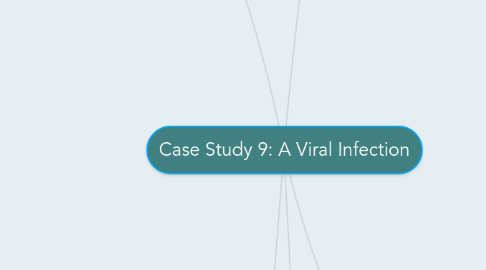
1. Tests
1.1. Enzyme-Linked ImmunoSorbent Assay (ELISA)
1.1.1. If the result:
1.1.1.1. Negative
1.1.1.1.1. Other tests are not usually needed
1.1.1.2. Positive
1.1.1.2.1. Test is repeated to confirm the diagnosis
1.1.2. To diagnose:
1.1.2.1. HIV,
1.1.2.2. Lyme disease
1.1.2.3. Pernicious anemia
1.1.2.4. Rotavirus
1.1.2.5. Squamous cell carcinoma
1.1.2.6. Varicella-zoster virus
1.2. Western blot
1.2.1. Done to confirm the results of two positive ELISA tests
1.3. Polymerase chain reaction (PCR)
1.3.1. Finds the RNA of the HIV virus or the HIV DNA in white blood cells infected with the virus
1.4. Indirect fluorescent antibody (IFA)
2. Humman Immunodeficiency virus
2.1. Mechanism of infection
2.1.1. Infection of cells
2.1.2. Integration of the provirus into host cell genome
2.1.3. Activation of viral replication
2.1.4. Release of infectious virus
2.2. Modes of transmission
2.2.1. Blood
2.2.2. Semen
2.2.3. Vaginal Fluids
2.2.4. Breast Milk
2.3. Prognosis
2.3.1. Acute HIV infection:
2.3.1.1. Develops within 2 to 4 weeks
2.3.1.2. HIV multiplies rapidly and spreads throughout the body
2.3.2. Chronic HIV infection
2.3.2.1. HIV continues to multiply in the body at very low levels
2.3.3. Development of AIDS: from 6 months to 15 years
2.3.4. NO CURE
2.3.5. Better prognosis with early treatment
2.3.6. Factors affecting it:
2.3.6.1. CD4 cell count
2.3.6.2. Viral load
2.3.6.3. Age
2.3.6.4. Developing of illness before HIV treatment
2.3.6.5. Infection with hepatitis B or C virus
2.3.6.6. Injecting drug use
2.3.6.7. Other health issues
2.3.6.7.1. E.g
2.4. Prevention
2.4.1. Post-exposure prophylaxis (PEP)
2.4.2. Prevention of mother-to-child transmission of HIV
2.4.3. Screening before blood transfusion
2.4.4. Using disposable syringe
2.5. Development of AIDS
2.5.1. Is the final stage of HIV infection
2.5.2. Body can’t fight off Opportunistic Infections
2.5.2.1. E.g
2.5.3. CD4 count of less than 200 cells/mm3
2.5.4. WITH AIDS patients survive about 3 years
2.6. Effect on Immune System
2.6.1. CD4 count
2.6.1.1. It can be used to tell what stage of HIV or AIDS
2.6.1.2. HIV targets CD4, so as an infected CD4 cell multiplies, it also makes more copies of HIV
2.6.1.3. Eventually, fewer HIV-free functioning CD4 cells
2.6.1.3.1. Result?
2.6.2. CD4-CD8 Ratio
2.6.2.1. What is normal?
2.6.2.1.1. CD4 => 400/mm3 ... CD8 = 200 to 800/mm3
2.6.2.2. CD8 cells kill the infected cells, this case CD4
2.6.2.3. Ratio become less than 1
2.7. Medication to manage
2.7.1. Antiretroviral therapy
2.7.1.1. Steps in viral replication that are targeted
2.7.1.1.1. Entry by gp 41 or chemokine co-receptors
2.7.1.1.2. Nucleic acid Reverse transcription by reverse transcriptase
2.7.1.1.3. Integration by integrase
2.7.1.1.4. Packaging and assembly by protease
3. STDs
3.1. What are they?
3.1.1. Diseases that are most often spread by sexual intercourse.
3.2. What increases the RISK?
3.2.1. i. Having more than one sex partner.
3.2.2. iii. Not having a safe sex.
3.2.3. iv. Sharing needles for intravenous drugs.
3.2.4. v. Trading sex for money or drugs.
3.3. What are the types?
3.3.1. Viral
3.3.1.1. E.g
3.3.1.1.1. HIV
3.3.1.1.2. Genital Herpes
3.3.1.1.3. Genital Warts (HPV)
3.3.1.1.4. Hepatitis B
3.3.2. Bacterial
3.3.2.1. E.g
3.3.2.1.1. Chlamydia
3.3.2.1.2. Gonorrhea
3.3.3. Parasitic
3.3.3.1. E.g
3.3.3.1.1. Trichomoniasis
4. Epidemiology
4.1. Epidemics of HIV
4.1.1. 0.8% of adults aged 15–49 years are living with HIV.
4.1.2. Sub-Saharan Africa is the most severely affected
4.1.3. 5 groups of adults at high risk of developing AIDS
4.1.3.1. Homosexual or bisexual men
4.1.3.2. Intravenous drug abusers
4.1.3.3. Hemophiliacs
4.1.3.4. Recipients of blood
4.1.3.5. Heterosexual contacts of members of other high risk groups
4.1.3.6. HIV infection of the new born
4.2. Notifiable Diseases In Qatar
4.3. Legal Issues
4.3.1. Patient with HIV are register in Ministry of Health
4.3.2. Deporting if expatriate
4.3.3. Work place should be informed
4.3.4. HIV patients knowingly infecting others should be arrested and imprisoned
5. After HIV!
5.1. Stages of Grief
5.1.1. Denial
5.1.2. Anger
5.1.3. Bargaining
5.1.4. Depression
5.1.5. Acceptance
5.2. Psychosocial aspect
5.2.1. Stigma & Discrimination
5.2.1.1. Why?
5.2.1.1.1. Regarded as death sentence
5.2.1.1.2. Misconception about transmission
5.2.1.1.3. Illegal sexual relationships
5.2.1.1.4. No anti-HIV medication so can cause epidemic
5.2.1.2. Lead to:
5.2.1.2.1. Rejection of whole family.
5.2.1.2.2. Segregated & treated differently
5.2.1.2.3. Loss of job.
5.2.1.2.4. Depression leading to suicide
5.2.2. Effect on family
5.2.2.1. Partner at risk of HIV infection
5.2.2.2. Strain in marriage
5.2.2.3. Obstruction in family planning
5.2.2.4. Grief due to loss of family member
5.3. Palliative house
5.3.1. Services are:
5.3.1.1. Pain control
5.3.1.2. Psychological and social support
5.3.1.3. Complementary therapies
5.3.1.4. Financial advice
5.3.1.5. Bereavement care
